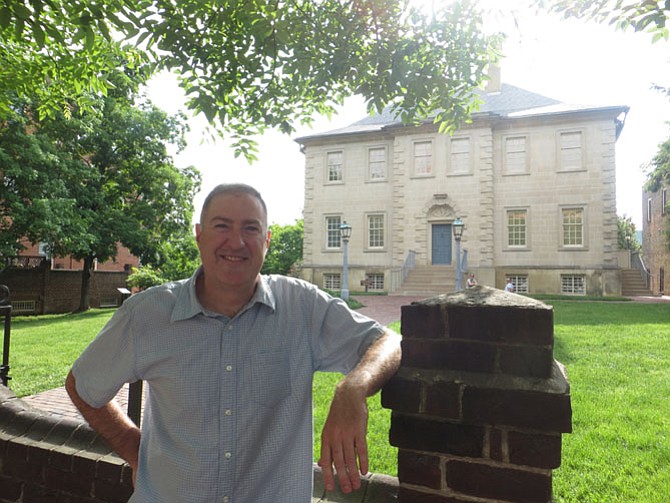Thomas Schultz outside the Carlyle House, the second stop on his Old Town Military Walking Tour. Photo by Vernon Miles.
In 1859, Augustine Washington deposited $200,000 in an Alexandria bank for safe keeping. The funds were planned to go towards restoration of Mount Vernon, but when the Union Army began seizing bank funds, the manager’s wife hid the funds among the clothes in her closet. When Union troops searched the bank manager’s home, they politely declined to search through her closet. The funds were later smuggled across the Potomac river to southern Maryland for safe keeping until after the war, when they were used to help pay for the historic preservation of Mount Vernon.
The bank is today the Athenaeum, one of the stops on Thomas Schultz’s Old Town Military Walking Tour, and the story is one of several pieces of local military. The tour is one of trips available through Shultz’s DC Military Tours.
DC Military Tours began on New Year’s Day of 2015 when Schultz retired after a 20-year career as a Supply Corp Naval Officer. Schultz said he has always had a passion for military history. Schultz earned a Master's Degree in Military Studies from the Marine Corps Command and Staff College in 2011. Schultz runs the “mom and pop tour business” with his wife, Eileen Shultz, a 10-year veteran of the Marine Corps. Hs wife manages their marketing and runs the business side of the company; the two have lived in Alexandria for 12 years.
DC Military Tours offers several themed tours around Virginia, D.C., and Maryland. Schultz’s personal favorite is one that follows the escape and manhunt of John Wilkes Booth. The Old Town Military Walking Tour costs $99 for a group of five or less.
Schultz said the idea came out of a realization that most other regional tours in large groups are often unable to access historic sites. Schultz says his tour sizes are part of what differentiates his tours from other tours around Alexandria and the D.C. area.
“We’re in groups of five or less,” said Schultz. “In other [regional] tours, it’s you and 75 of your closest friends in a bus. The smaller group is more intimate and allows flexibility in the length of the tour. We can spend an extra hour at a location, won’t rush a conversation with a docent, and you can eat when you’re hungry.”
While some groups want a full four hour experience, some visitors on a tighter time frame can have the tour slimmed to an hour and a half “speed through.”
“With a big group of 75 or even 25 people, you can only do so much,” said Thomas Schultz. “A group of five or less is digestible. Museums and historic houses are often uncomfortable with larger groups. Schultz said he’s experienced this with two sites on his tour in particular: Gadsby’s Tavern Museum and the Carlyle House.
“Because we’re a historic site, we can only accommodate certain group numbers,” said Vanessa Herndon, an educational assistant at the Carlyle House. “We’ve had groups as large as 50 people, but we have to break that up into smaller groups. Groups under 30 are best.”
According to Bitsy Unkle at Visit Alexandria, there are several other tour groups operating in Old Town. Footsteps to the Past hosts historic and ghost tours of the city. Others, like DC Food Tours, visit different restaurants in Old Town. Still, while Unkle said that all of the tours cover different parts of the city’s past, Schultz’s focus on military history is different.
As a new small business, Schultz said he was surprised to see how many local organizations were quick to assist with manpower or connections. He received support from the Alexandria Chamber of Commerce, Visit Alexandria, the Old Town Civic Association, the Military Officer’s Association of America, the Capitol Post, and the Alexandria Small Business Association. Many of those organizations helped Schultz with marketing DC Military Tours, specifically on utilizing social media.
Schultz said another invaluable asset has been the local citizens who go on the tours with him.
“No historian is all knowing,” said Schultz. “You learn something new on each tour.”
Many of the churches around Alexandria had been converted into hospitals by the Union Army during the Civil War. Schultz said he knew that St. Mary’s Catholic Church was spared because of the large amount of Irish troops in the military and Christ Church was not used out of reverence to Washington, but learned from someone one a recent tour that the First Presbyterian Church was not used as a hospital because it had an overwhelmingly unionist congregation.
As Schultz walked past the Carlyle House, he marveled at the historic building wedged in the middle of Alexandria.
“When this house was built in 1752, Alexandria was just an idea,” said Schultz. “From paper to completion, it took three years to build and it was one of the first buildings in the area. I don’t know what we could do this that quickly in this day and age … Local people take for granted what’s in their own back yard, and they always think they can go and do it another day.”
